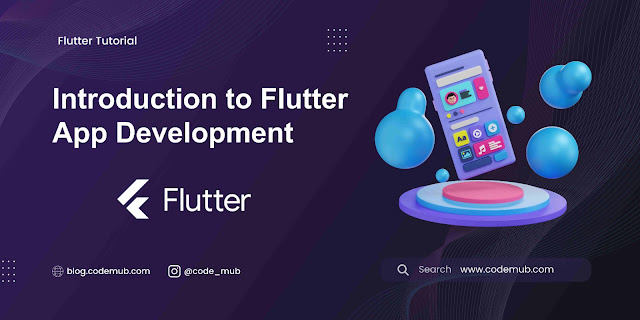Introduction to Flutter App Development
Introduction
In this series, we will guide you through the exciting world of Flutter app development, covering everything from the basics to advanced topics. Whether you're just starting out or an experienced developer looking to expand your skills, this series is designed to help you create beautiful and high-performing cross-platform applications.
What is Flutter?
Flutter is an open-source UI software development toolkit developed by Google. It enables developers to build native for mobile, web, and desktop platforms using a single codebase. Flutter utilizes the Dart programming language and follows a reactive, declarative programming approach.
One of the key features of Flutter is its widget-based architecture. In Flutter, everything is a widget, from the simplest button to complex layouts. This design allows for easy composition and customization of user interfaces with a high level of flexibility.
Features of Flutter
Hot Reload: Flutter's Hot Reload feature empowers developers to experiment, build UIs, add features, and fix bugs with excellent efficiency. With Hot Reload, you can instantly see the results of your changes without restarting the app, speeding up the development process.
Cross-Platform Development: Flutter allows you to write code once and use it across multiple platforms like iOS, Android, web, and desktop. This unified codebase reduces development time and effort.
Rich Set of Widgets: Flutter provides an extensive collection of customizable widgets that facilitate the creation of beautiful and responsive user interfaces. These widgets can be easily tailored to meet the design requirements of your application.
Access to Native Features: Flutter allows developers to access native features and APIs, ensuring that your app can leverage platform-specific capabilities to their fullest extent.
Table of Contents
Advantages of Flutter
Faster Development: The combination of Hot Reload and a single codebase for multiple platforms accelerates the development process and shortens time-to-market for applications.
Expressive and Flexible UI: Flutter's widget-based system empowers developers to create highly expressive and flexible user interfaces, resulting in rich and engaging user experiences.
Strong Community Support: Flutter boasts a vibrant and active community of developers. This means you'll have access to abundant resources, tutorials, and packages that contribute to an enriching development experience.
Excellent Performance: Flutter apps are compiled to native machine code, ensuring high performance across various platforms. This guarantees a seamless and responsive user experience.
Prerequisites
Before diving into Flutter development, there are a few prerequisites you should be aware of:
Dart Programming Language: Flutter primarily utilizes the Dart programming language. If you're new to Dart, don't worry; it's designed to be easy to learn, especially if you have experience with languages like Java, JavaScript, or C#.
Understanding of Object-Oriented Programming (OOP): Dart follows the principles of object-oriented programming. It's beneficial to have some familiarity with OOP concepts like classes, objects, inheritance, and polymorphism before delving into Flutter development.
Experience with a Text Editor or IDE: You can use various text editors or integrated development environments (IDEs) for Flutter development. Popular choices include Visual Studio Code, Android Studio, and IntelliJ IDEA. Familiarity with any of these tools is useful.
Basic Knowledge of Mobile App Development Concepts: While not strictly required, having a basic understanding of mobile app development concepts can be helpful. This includes knowledge of UI/UX design, application lifecycle, and basic app architecture.
Version Control System (Optional but Recommended): Using version control systems like Git is not mandatory but highly recommended for collaborative development and code management.
Before you begin Flutter development, ensure that you have the Flutter SDK and Dart SDK installed on your machine. The official Flutter documentation provides detailed instructions for setting up your development environment: Flutter - Get Started.
Keep in mind that Flutter is designed to be accessible to developers with various backgrounds, so even if you're new to Dart or mobile development, you can quickly get started with the resources available in the Flutter community and documentation.
To get started, follow these steps:
Flutter SDK: Download and install the Flutter SDK from the official Flutter website here.
IDE: Choose an Integrated Development Environment (IDE) such as Visual Studio Code or Android Studio. Install the required plugins for Flutter development.
Dart SDK: Flutter uses the Dart programming language, so make sure you have the Dart SDK installed alongside the Flutter SDK.
FAQs on Flutter Tutorial
Q1: Is Flutter only for mobile app development?A1: No, Flutter supports multi-platform development. You can use it to build apps for mobile, web, and desktop.
Q2: Is Dart a difficult language to learn?A2: Dart is designed to be easy to learn, especially if you have experience with languages like Java or JavaScript.
Q3: Can I use Flutter for existing native projects?A3: Yes, Flutter can be integrated into existing native projects, allowing you to gradually adopt it.
Q4: Are there any limitations to Flutter?A4: While Flutter is a powerful framework, it may not be the best choice for certain resource-intensive applications or projects with specific platform dependencies.
In the upcoming posts in this series, we'll delve deeper into Flutter development, covering topics such as widget basics, state management, navigation, and more. Stay tuned for an exciting journey into the world of Flutter!



